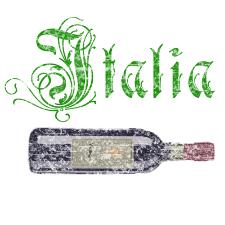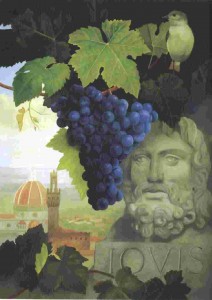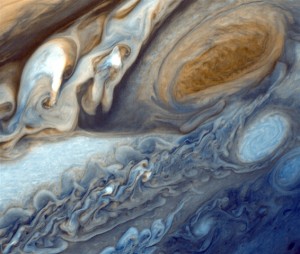by Lorri | Nov 9, 2011 | UnCorked
 Sangiovese, Nebbiolo and Barbera, despite their discreet natures, are sometimes called the “Italian Mob.” They earned this moniker because of their dominance in the Italian wine industry. Their hierarchy status rarely gets recognition on labels, and the wines take a back seat to the international familiarity of chardonnay and cabernet sauvignon. But these wines shouldn’t be ignored.
Sangiovese, Nebbiolo and Barbera, despite their discreet natures, are sometimes called the “Italian Mob.” They earned this moniker because of their dominance in the Italian wine industry. Their hierarchy status rarely gets recognition on labels, and the wines take a back seat to the international familiarity of chardonnay and cabernet sauvignon. But these wines shouldn’t be ignored.
Sangiovese has been associated with the inexpensive raffia-covered bottles sitting on restaurant tables around the world. But at its best, it is the grape behind Chianti from the Tuscany region.
These serious wines are brilliantly concentrated with earthy rich plum and black cherry, and because of their gripping tannins, they have the ability to age to perfection.
Nebbiolo, the famous grape behind the Barolo wine, is grown in Italy’s northwest region of Piedmont.
When compared to other grapes in this lineup, it is by far the most renowned for making aggressive, highly tannic red wines with alluring aromas and flavors — floral, roasted meats and spice.
Last but not least is the Barbera, which has played second fiddle to the Nebbiolo. Barbera grows throughout Italy, but it is in the vineyards of Piedmont that for centuries the most concentrated and complex examples of this grape have been grown. Its style can be fresh and fruity with cherry flavors or a full-bodied intense wine.
THE VALUES
- 2009 Cecchi Chianti Classico, Italy (about $15 retail)
- 2009 Da Vinci Chianti, Italy (about $21 retail)
- 2009 Michele Chiarlo Barbera d’ Asti, Italy (about $15 retail)
THE SPLURGES
- 2009 Santa Margherita Chianti, Italy (about $30 retail)
- 2009 Antinori Peppoli Chianti Classico, Italy (about $30 retail)
by Lorri | May 11, 2011 | UnCorked
 Last week’s column on the story of the Chianti Classico rooster was just the beginning of my exploration of the colossal offerings of the prolific Italian wine region.
Last week’s column on the story of the Chianti Classico rooster was just the beginning of my exploration of the colossal offerings of the prolific Italian wine region.
With more than 27 percent of the region’s sales occurring in the United States, you would expect U.S. consumers to have a good understanding of this region.
There is some confusion, though, likely the result of the sheer immensity of Italian wine offerings.
The primary grape of the Chianti region is the sangiovese, which flourishes on the Tuscan hillsides between Florence and Siena.
Chianti Classico must contain a minimum 80 percent sangiovese, and during my visit many Chianti producers expressed a shift to 100 percent — known as “pure” — to truly showcase the spirit of the sangiovese grape. Other grapes, such as the local canaiolo and colorino or cabernet sauvignon and merlot, can be added. Traditionally the white grapes trebbiano and malvasia were used, but since 2006 they are no longer allowed.
Chianti Classico wines have two distinct styles: the Vintage Year (annual) and Riserva (reserve). The vintage year is a fresh, fruity wine meant to be consumed young. A riserva is much different and strikes a balance between elegance and potency. Riserva wines are aged to provide the finest expression of sangiovese with its full-bodied, complex style. To qualify as a riserva, strict standards must be met, including a minimum of 12.5 percent alcohol, maturation for a minimum of 24 months with at least 3 months in the bottle before going to market.
THE VALUES
- 2008 Castello di Monastero Chianti Classico, Italy (about $24 retail)
- 2008 San Jacopo Chianti Classico, Italy (about $21 retail)
- 2009 Banfi Chianti Classico, Italy (about $15 retail)
- 2008 Cecchi Chianti Classico, Italy (about $18 retail)
THE SPLURGES
- 2008 Villa Antinori Peppoli Chianti Classico, Italy (about $32 retail)
- 2008 Dievole Chianti Classico Riserva, Italy (about $64 retail)
- 2008 Melini Terrarossa Laborel Chianti Classico Riserva, Italy (about $32 retail)
by Lorri | Mar 16, 2011 | UnCorked
 Sangiovese (san-joh-VAYzeh) is one of the world’s illustrious and most enduring grapes. It achieves its greatness in the soils of Italy, where it has been known for centuries as the Blood of Jove (Jupiter).
Sangiovese (san-joh-VAYzeh) is one of the world’s illustrious and most enduring grapes. It achieves its greatness in the soils of Italy, where it has been known for centuries as the Blood of Jove (Jupiter).
If you are not familiar with this grape, you are not alone. One reason could be because of the confusing European practice of naming wines not for the grape from which it is made, but from the area where it is produced — in this case, the Chianti region of Tuscany.
When most people think of Chianti they have visions of the raffia-covered bottle that used to sit on almost every Italian restaurant table in the world. Made to be a bulk inexpensive wine, these light, thin, austere and astringent wines usually ranged somewhere between mediocre and dreadful.
For many years the grape was grown either haphazardly in random vineyards or for a large-scale production with cooperatives.
Today many Italian producers have placed emphasis on growing Sangiovese with care, making it at its best brilliantly concentrated with spiced plum, black cherry and an integrated spicy mellowness. Simply said — a beautiful wine.
THE VALUES
- 2007 Cecchi Bonizio Sangiovese, Italy (about $14 retail)
- 2009 Bolla Chianti, Italy (about $12 retail)
- 2009 Rocca Chianti Rubizzo Sangiovese, Italy (about $18 retail)
- 2009 Bella Sera Chianti, Italy (about $10 retail)
THE SPLURGES
- 2008 Da Vinci Chianti Riserva, Italy (about $30 retail)
- 2008 Banfi Chianti Classico Riserva, Italy (about $23 retail)
- 2008 Santa Margherita Chianti, Italy (about $42 retail)
- 2005 Castello D’Albola Chianti Classico, Italy (about $26 retail)
 Sangiovese, Nebbiolo and Barbera, despite their discreet natures, are sometimes called the “Italian Mob.” They earned this moniker because of their dominance in the Italian wine industry. Their hierarchy status rarely gets recognition on labels, and the wines take a back seat to the international familiarity of chardonnay and cabernet sauvignon. But these wines shouldn’t be ignored.
Sangiovese, Nebbiolo and Barbera, despite their discreet natures, are sometimes called the “Italian Mob.” They earned this moniker because of their dominance in the Italian wine industry. Their hierarchy status rarely gets recognition on labels, and the wines take a back seat to the international familiarity of chardonnay and cabernet sauvignon. But these wines shouldn’t be ignored. Last week’s column on the story of the Chianti Classico rooster was just the beginning of my exploration of the colossal offerings of the prolific Italian wine region.
Last week’s column on the story of the Chianti Classico rooster was just the beginning of my exploration of the colossal offerings of the prolific Italian wine region. Sangiovese (san-joh-VAYzeh) is one of the world’s illustrious and most enduring grapes. It achieves its greatness in the soils of Italy, where it has been known for centuries as the Blood of Jove (Jupiter).
Sangiovese (san-joh-VAYzeh) is one of the world’s illustrious and most enduring grapes. It achieves its greatness in the soils of Italy, where it has been known for centuries as the Blood of Jove (Jupiter).